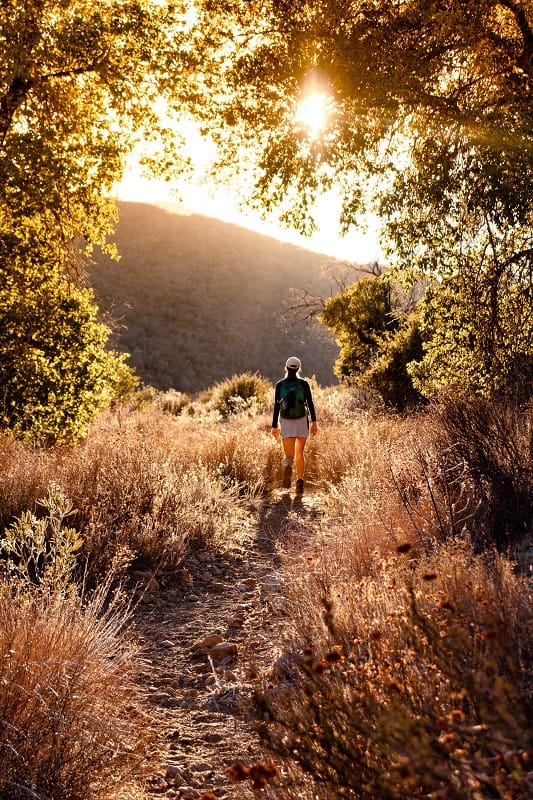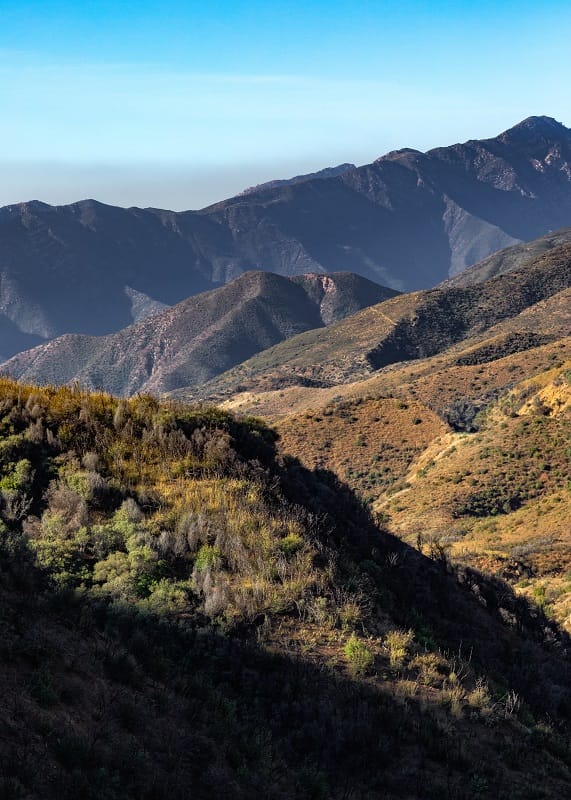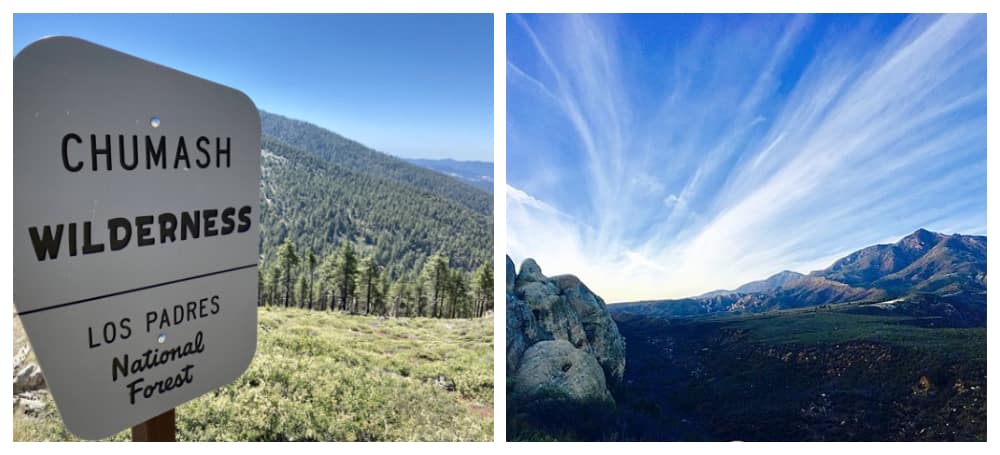A Confluence of Place
By, Chimaway Lopez

Growing up with the stories shared by my elders fostered my familiarity with the trails and roads, plants and animals that make up Montecito. For me, these are storied places. Walking on our trails brings these stories into the material, as the plants, animals, rocks, and insects bring back memories, offer new ones, and give lessons about how I should be in this place.
So, a trail can be many things: a path, a story, a connection. Thinking deeply for a moment, a trail is, for me, a bundle of social, ecological, geological, hydrological streams of causality that work together to shape the trail’s being and also its continued emergence. But before all of this; the plants, animals, insects, rocks and springs; the hikers, engineers, volunteers and recreationalists; the picks, shovels, saws, and shears; even before the very idea of a trail, my elders saw a confluence of place: a trail is from a place, through a place, towards a place, and exists as a manifestation of this being-ness within place, space, and time. Walking through our trails is to think alongside these old-time Chumash philosophers. My experience is that if you listen carefully and ask the right questions, you can begin to make a connection. What kinds of beings first traveled these trails? What gifts, weights or obstacles did they carry with them? What were they grateful for and what were they wary of? I am inviting you to pause a moment, to reflect, and think beyond the surface answers of the tourist postcards and brochures: What does this confluence of being-in-motion mean to you?
On the level of the concept of being, these are not easy questions. In fact, they are the kind of questions that I hope to carry with me throughout my life, guiding me into those stories and places that make me who I am. Chumash culture, philosophy, and spirituality is the culmination of thousands of years and hundreds of generations of mutual being, learning, and growing alongside the places that constitute Chumash territory, a practice that Chumash people collectively continue to carry with them as we move along trails and through places in Montecito and beyond. While the last 200 years of colonization has caused a rupture in the ecological and spiritual practices that shape Chumash culture and, reflexively, the place that is our home, my elders understood that beneath these political, cultural, emotional, and ecological wounds, the spirit of place remains. It is this spirit that is manifested within the ecology, morphology, and social presence of a trail. A trail creates as much as it is created and it will gift just as much as you give.
Rather than simply offering fragments of a Chumash perspective, I hope that following these short essays inspires you to listen, feel, and think along-side the trails that we all too often assume are inert; convenient ways of escaping the bureaucratic monotony of modernity. Today, as we witness the overwhelming effects of a dominating Human agency that continues to act unsustainably on a geological scale, it is more important than ever to humble ourselves and follow these difficult questions as we admire the beauty of these places here in Montecito: how do I exist and how am I in relation to this confluence of place? What does it inspire in me?

Qayas:
(Elderberry)
Walking past a budding qayas, I might almost miss the early shoots. Inconspicuously growing on the side of a trail, springing out from an old oak or sycamore, there might be one or two curved branching stems, orange brown, textured, and pungent; small sets of leaflets, light green to yellow, waiting their turn to grow. An elderberry like this is potential that is waiting to emerge. Given the right conditions, water, space, time, care, qayas will grow from a shrub into a tree with straight shoots, healthy leaves, and a canopy of flowers or berries. It has cared for Chumash people since time immemorial. And we care for it in return.
Seeing qayas along the trail returns me to those gatherings, ceremonies, and celebrations that are brought to my mind with the sound of the wansak, our split-stick rattle. Within it’s wood are the songs of future generations, gifted by that spirit that has warmed the hearts, healed the souls, and brought joy to our people.
When Elderberries bloom, their presence is unmistakable. The cream colored flowers face upwards, as if standing up straight or looking at the sky. A full grown healthy qayas is full of abundance: hundreds of flowers and, later in the season, berries; enough to share with the birds and still save plenty to help your family until next season. In this way our relatives taught us about sharing, gifting, and caring for each other. That's what I feel when I pass qayas along the trail.
Štayǝt:
(willow)
I set my tent up under a tall štayǝt, and I felt at home. Prune the branches carefully, so that they will shoot up healthy, straight, and strong. Peel the bark and lash the limbs together to hang your meal over the cooking fire. I taste the bitterness of the bark, and I feel at home.
Štayǝt is beautiful: long, green leaves, bark mottled gray, shoots that may turn red in the new growth, depending on the species. The inner bark can be a light yellow or a bright lime green. To me, willow is a good sign. I see a creek, a river, a spring. I see a ceremony arbor, branches twisted together, honoring the earth, the sky, and the directions. It brings people in, it reminds us that we are a part of this place. Even if we no longer make our ’aphaniš, our village, upon a willow scaffold, štayǝt continues to bring our people together.
With its flexible branches and fibrous bark, štayǝt invites creativity: a fish trap, a cradleboard, a tanning rack, a storage bin. In its generosity it inspires and creates, and when you know how to take care of it, it will continue to shoot up, straight, drawing a line from the water towards the sun. I see a willow along the trail and think: “Hello there relative, it is good to see you again.”
Kuw’:
(oak)
Hearing the crunch of the prickly leaves under my feet, I look up at the sprawling canopy of this age-old kuw’. “You must be old to have grown such a canopy, you knew my grandfather didn’t you? He walked up this canyon didn’t he?” I can smell the dusty oak duff, that's a good smell. I focus my attention again and make out the shrill chirp of the oak titmouse, and the bell-like trill of a pair of juncos. I wonder if it's the right time of year to be dropping acorns? I should know that... but I don’t. Have the deer and the squirrels been around? It feels good to be under that oak tree, it gives me that old-time feeling.
There’s nothing like šǝpǝtǝš, acorn meal, if you have the taste for it. It's a good kind of bitter, one that sticks in your memory, brings you back to ceremony time, or acorn ash cakes around the fire. But there's more there than just one lifetime of feeling, there's that intergenerational memory. Do you recognize me, relative? It's been too long since we have paid attention to you. I feel it's time again to bring out the šǝpǝtǝš. In time you'll feed the people again.
The oak tree branching over us feels like a grandparent, gifting food, shelter, nutrients to the people, plants, and animals. I've seen that qimš, hummingbird sage, likes to grow in its shade, and through the ku’w, in this moment, we are both connected.

Yasis:
(poison oak)
I was taught that up and down the trails there are lessons, things you pick up, sometimes without noticing. Sometimes you pick up too many things and you end up with something you shouldn’t have. That’s how I have come to think about yasis, poison oak. I find that, only after years of internalizing negative images and associations of the plant, that its presence is important, a reminder of the need to pay attention to the trail and how you relate to the beings that inhabit it.
Of course, everyone’s relationship with yasis is different. Many of those old timers didn’t seem to be affected by it at all, while there are plenty of people who react much more severely to the natural oils of the plant with minimal contact. In my own experience, somewhere in the middle, poison oak becomes an issue when you stop paying attention and do not take the time to learn your own boundaries and responsibilities. I see a qayas full of berries, for example, and rush forward, forgetting in my enthusiasm to be mindful of the where and who of the trail. Be patient, be grateful, be conscious of those around you; all moral principles that I have learned to value.
So, yasis is humbling. It challenges me to not get ahead of myself and live by my own convictions. It also offers a reminder to each of us, that we all have unique relationships and experiences along these trails. No matter your history with the plant, I believe that respecting and accepting yasis for the role it plays on the trail and in our own minds is an important step in understanding our presence as we move through Montecito.
Štemelel:
(giant wild rye grass)
You can often see štemelel growing along the freeway on the coast in Chumash territory, and it always feels to me like seeing an old friend on the side of the road. A conspicuous species, it is my reminder of the abundance and diversity of native grasslands.
I remember walking up the creek-side to a mountain spring. I stopped by the štemelelel to cut back the dead flower stalks, keeping the hollow cane and rolling the segments in my hands. The water dripped down the rocks, followed slowly by the moss with its deep greens and yellow-browns. There is something so powerful about the presence of a spring, the spiritual, historical, hydrological importance; signalling towards the ancient geological agency within the mountains.
I heard that they found scalding water deep in the mountain when they dug the tunnels to bring water first from Gibraltar and then, later, Cachuma reservoirs. I heard it spewed out and the water company was able to use the tunnel as a water source during construction.
So, I was thinking about this gift of fresh water as I dug a small pool under the spring, watching the water fill as it filtered through the earth and stone. I cut a segment of štemelel between its nodes, cleaning the sharp edges off to form a straw, dipping it into the pool and drinking. Geologists can describe the fault systems interacting with water tables and how the mountains move through plate tectonics. My elders describe the mountains as living, in their own way, breathing, gifting, responding. In my own life, experienced through my štemelel straw at that mountain spring, these understandings are interrelated. That's the kind of feeling I get when I see štemelel on the side of the road.
Šu’:
(mulefat)
Walking up the creek bed, I stop by a spindly shrub, shoots jutting out into spear shaped leaves that might resemble willow if it weren’t for the slightly toothed margins. The small clumps of flowers are a welcome sign, and I cut back a straight dead shoot working the buds smooth with my knife. What I see in my hands as I straighten out the mulefat shoot is fire, and with the right technique and knowledge, this fire-stick can spin an ember into life. Gently add breath, and you have a flame. Making fire by hand is a beautiful thing: humbling, frustrating, and so rewarding at the same time. It relies upon understanding the relationship between plants, water, weather, yourself. For me, it is also a spiritual and philosophical practice. An elder told me that fire is a connection to the ancestors, so gathering around the fire and tending to it brings us closer to them.
Fire and water are two things that are essential to our existence as human beings, they hydrate us, warm us, produce food and help prepare that food for our consumption. Fire and water are also two fundamental aspects of chaparral ecology. Our plant relatives in these mountains have developed fascinating ways to live with the cycles of drought and fire disturbance that shape our home, creating a complex set of relations that is reflected not only in the non-human beings that live in Chumash country, but also the philosophy and culture that has developed in relation to these places. To understand wet/dry and heat/cold, to pull them apart and bring them together, is the brilliance of firemaking, and šu’ embodies these principles. Šu’, a plant that creates fire, also grows abundantly in riparian zones with its roots in an arroyo. One cannot exist without the other.
Today we are seeing this relationship of fire and water slip: droughts and floods are exacerbated, fires burn so hot and far that they scald the landscape, putting ourselves and our non-human relatives in danger. While we cannot know for certain what this means for the future of our trails here in Montecito, from my perspective it is now more important than ever to pay attention to how we exist in these places. It gives me hope that these plant relatives can continue to help our community heal and build our own future, even if we have difficult years ahead. So I will continue to look for šu’ along the creek bed, and pay attention to the lessons that it generously gives on how to be the best ancestor I can be.
***
Photo Credit: https://www.fs.usda.gov/activity/lpnf/recreation/hiking
Greekmatthew, CC BY-SA 4.0 <https://creativecommons.org/licenses/by-sa/4.0>, via Wikimedia Commons
Photo by Dave Hoefler on Unsplash
Photo by Erin O'Brien on Unsplash
